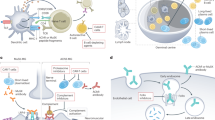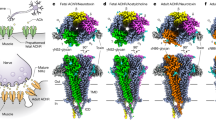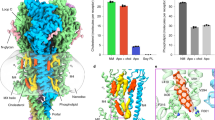Abstract
Aim:
To investigate the effect of magnesium sulfate and its interaction with the non-depolarizing muscle relaxant vecuronium at adult muscle-type acetylcholine receptors in vitro.
Methods:
Adult muscle-type acetylcholine receptors were expressed in HEK293 cells. Drug-containing solution was applied via a gravity-driven perfusion system. The inward currents were activated by brief application of acetylcholine (ACh), and recorded using whole-cell voltage-clamp technique.
Results:
Magnesium sulfate (1–100 mmol/L) inhibited the inward currents induced ACh (10 μmol/L) in a concentration-dependent manner (IC50=29.2 mmol/L). The inhibition of magnesium sulfate was non-competitive. In contrast, vecuronium produced a potent inhibition on the adult muscle-type acetylcholine receptor (IC50=8.7 nmol/L) by competitive antagonism. Magnesium sulfate at the concentrations of 1, 3, and 6 mmol/L markedly enhanced the inhibition of vecuronium (10 nmol/L) on adult muscle-type acetylcholine receptors.
Conclusion:
Clinical enhancement of vecuronium-induced muscle relaxation by magnesium sulfate can be attributed partly to synergism between magnesium sulfate and non-depolarizing muscle relaxants at adult muscle-type acetylcholine receptors.
Similar content being viewed by others
Log in or create a free account to read this content
Gain free access to this article, as well as selected content from this journal and more on nature.com
or
References
Howell P . Spinal anesthesia in severe preclampsia: time for reappraisal or time for caution? Int J Obstet Anesth 1998; 7: 217–9.
Aya AG, Mangin R, Vialles NV, Ferrer JM, Robert C, Ripart J, et al. Patients with severe preeclampsia experience less hypotension during spinal anesthesia for elective cesarean delivery than healthy patients: a prospective cohort comparison. Anesth Analg 2003; 97: 867–72.
Lipman S, Carvalho B, Brock-Utne J . The demise of general anesthesia in obstetrics revisited: prescription for a cure. Int J Obstet Anesth 2005; 14: 2–4.
Ross RM, Backer T . An effect of magnesium on neuromuscular function in parturients. J Clin Anesth 1996; 8: 202–4.
Yoshida A, Itoh Y, Nagaya K, Takino K, Sugawara J, Murakami T, et al. Prolonged relaxant effects of vecuronium in patients with deliberate hypermagnesemia: time for caution in cesarean section. J Anesth 2006; 20: 33–5.
Fuchs-Buder T, Wilder-Smith OH, Borgeat A, Tassonyi E . Interaction of magnesium sulphate with vecuronium-induced neuromuscular block. Br J Anaesth 1995; 74: 405–9.
Krendal DA . Hypermagnesemia and neuromuscular transmission. Semin Neurol 1990; 10: 42–5.
McLarnon JG, Quastel DM . Postsynaptic effects of magnesium and calcium at the mouse neuromuscular junction. J Neurosci 1983; 3: 1626–33.
Del Castillo J, Engbaek L . The nature of the neuromuscular block produced by magnesium. J Physiol 1954; 124: 370–84.
Grassi F, Degasperi V . Modulation of fetal and adult acetylcholine receptors by Ca2+ and Mg2+ at developing mouse end-plates. Pflugers Arch 2000; 440: 704–9.
James MFM . Magnesium in obstetric anesthesia. Int J Obstet Anesth 1988; 7: 115–23.
Imoto K, Busch C, Sakmann B, Mishina M, Konno T, Nakai J, et al. Rings of negatively charged amino acids determine the acetylcholine receptor channel conductance. Nature 1998; 335: 645–51.
Paul M, Kindler CH, Fokt RM, Dresser MJ, Dipp NC, Yost CS . The potency of new muscle relaxants on recombinant muscle-type acetylcholine receptors. Anesth Analg 2002; 94: 597–603.
Wang H, Zhang Y, Li ST . The effect of local anesthetics on the inhibition of adult muscel-type nicotinic acetylcholine receptors by nondepolarizing muscle relaxants. Eur J Pharmacol 2010; 630: 29–33.
Garland CM, Foreman RC, Chad JE, Holden-Dye L, Walker RJ . The actions of muscle relaxants at nicotinic acetylcholine receptor isoforms. Eur J Pharmacol 1998; 357: 83–92.
Sine SM, Taylor P . Relationship between reversible antagonist occupany and the functional capacity of the acetylcholine receptor. J Biol Chem 1981; 256: 6692–9.
Fletcher GH, Steinbach JH . Ability of nondepolarizing neuromuscular blocking drugs to act as partial agonists at fetal and adult mouse muscle nicotinic receptors. Mol Pharmacol 1996; 49: 938–47.
Baraka A, Yazigi A . Neuromuscular interaction of magnesium with succinylcholine-vecuronium sequence in the eclamptic parturient. Anesthesiology 1987; 67: 806–8.
Wang H, Yang B, Xu YF, Yan T, Li ST . Magnitude differences of resistance to different nondepolarizing muscle relaxants in the denervated mouse skeletal muscle. Acta Pharmacol Sin 2010; 31: 399–404.
Wang H, Yang B, Han GW, Li ST . Potency of nondepolarizing muscle relaxants at muscle-type acetylcholine receptors in denervated mouse skeletal muscle. Acta Pharmacol Sin 2010; 31: 1541–6.
Acknowledgements
This work was supported by the National Natural Science Foundation of China (No 30571796).
Author information
Authors and Affiliations
Corresponding author
Rights and permissions
About this article
Cite this article
Wang, H., Liang, Qs., Cheng, Lr. et al. Magnesium sulfate enhances non-depolarizing muscle relaxant vecuronium action at adult muscle-type nicotinic acetylcholine receptor in vitro. Acta Pharmacol Sin 32, 1454–1459 (2011). https://doi.org/10.1038/aps.2011.117
Received:
Accepted:
Published:
Issue date:
DOI: https://doi.org/10.1038/aps.2011.117
Keywords
This article is cited by
-
Clinical efficacy of magnesium sulfate injection in the treatment of masseter muscle trigger points: a randomized clinical study
BMC Oral Health (2022)
-
Dexmedetomidine versus magnesium sulfate as adjunct to general anesthesia in patients undergoing video-assisted thoracoscopy
Ain-Shams Journal of Anesthesiology (2022)
-
The effect of magnesium on the reversal of rocuronium-induced neuromuscular block with sugammadex: an ex vivo laboratory study
BMC Anesthesiology (2019)
-
Response to Higashi et al.
JA Clinical Reports (2019)



